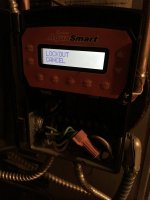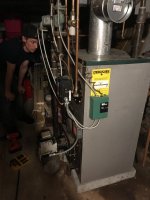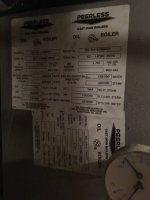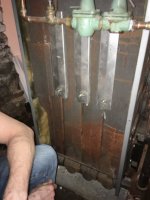Cold in PA
New Member
As my username suggests- we are cold in PA. Our oil provides heat and hot water to a 2400 sq ft house and the bill is roughly $6000 per year. We can't afford to heat the house any longer- it's about $750-800 every 5/6 weeks, 3 seasons a year and the summer is not much better. After some research I realized we have a few problems...
-I think the boiler is oversized. My husband made these exact boilers at a previous job and this is one of the biggest ones he seen.
- The basement is always VERY warm, the warmest room in the house, even with a window that is always open (no glass, husband has had it on the to do list for years). Despite this, basement is a sauna all year. So, we are producing the heat but it's just not reaching the upstairs.
-Lastly the boiler is a hot start system. Unfortunately it is also a tankless coil. I would like to convert it to a coldstart and add an indirect tank, so I was running a test by disabling the low limit on the Beckett aquasmart and calling for heat from the thermostat to see whether or not the boiler will leak while frequently starting from low temperatures. This leads me to my latest problem…
- Ever since starting this cold start test, the relief valve has been pouring out water when starting from cold temperatures.
-Even more confusing is that the Beckett Aquasmart has now started to malfunction. It is reading "lockout cancel". Per the manual this means the cancel button was held for longer than five seconds..but the cancel button was never held. Sometimes the Aquasmart stays locked out for hours on end and then all of a sudden comes back on for about 2 to 3 seconds and then dies, reading "lock out cancel". When it starts to cycle of on and off, it will do this indefinitely until I disable the burner.
Good news however, the boiler itself has not yet leaked so there is hope and converting our existing boiler, Peerless EC4, to a coldstart. If anyone has any insight please let me know. We have electric heaters going for now and the baby is bundled up, but I need to get figured out ASAP. I plan to call HVAC tech tomorrow but would like some information to go on first...thanks in advance!
-I think the boiler is oversized. My husband made these exact boilers at a previous job and this is one of the biggest ones he seen.
- The basement is always VERY warm, the warmest room in the house, even with a window that is always open (no glass, husband has had it on the to do list for years). Despite this, basement is a sauna all year. So, we are producing the heat but it's just not reaching the upstairs.
-Lastly the boiler is a hot start system. Unfortunately it is also a tankless coil. I would like to convert it to a coldstart and add an indirect tank, so I was running a test by disabling the low limit on the Beckett aquasmart and calling for heat from the thermostat to see whether or not the boiler will leak while frequently starting from low temperatures. This leads me to my latest problem…
- Ever since starting this cold start test, the relief valve has been pouring out water when starting from cold temperatures.
-Even more confusing is that the Beckett Aquasmart has now started to malfunction. It is reading "lockout cancel". Per the manual this means the cancel button was held for longer than five seconds..but the cancel button was never held. Sometimes the Aquasmart stays locked out for hours on end and then all of a sudden comes back on for about 2 to 3 seconds and then dies, reading "lock out cancel". When it starts to cycle of on and off, it will do this indefinitely until I disable the burner.
Good news however, the boiler itself has not yet leaked so there is hope and converting our existing boiler, Peerless EC4, to a coldstart. If anyone has any insight please let me know. We have electric heaters going for now and the baby is bundled up, but I need to get figured out ASAP. I plan to call HVAC tech tomorrow but would like some information to go on first...thanks in advance!




